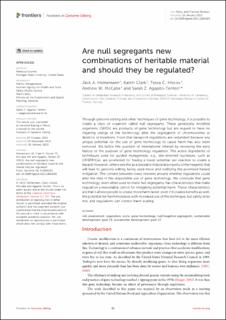| dc.contributor.author | Heinemann, Jack A. | |
| dc.contributor.author | Clark, Katrin | |
| dc.contributor.author | Hiscox, Tessa C | |
| dc.contributor.author | McCabe, Andrew W. | |
| dc.contributor.author | Agapito, Sarah Zanon | |
| dc.date.accessioned | 2023-09-01T13:01:51Z | |
| dc.date.available | 2023-09-01T13:01:51Z | |
| dc.date.created | 2023-02-21T14:35:48Z | |
| dc.date.issued | 2023 | |
| dc.identifier.issn | 2673-3439 | |
| dc.identifier.uri | https://hdl.handle.net/11250/3087059 | |
| dc.description.abstract | Through genome editing and other techniques of gene technology, it is possible to create a class of organism called null segregants. These genetically modified organisms (GMOs) are products of gene technology but are argued to have no lingering vestige of the technology after the segregation of chromosomes or deletion of insertions. From that viewpoint regulations are redundant because any unique potential for the use of gene technology to cause harm has also been removed. We tackle this question of international interest by reviewing the early history of the purpose of gene technology regulation. The active ingredients of techniques used for guided mutagenesis, e.g., site-directed nucleases, such as CRISPR/Cas, are promoted for having a lower potential per reaction to create a hazard. However, others see this as a desirable industrial property of the reagents that will lead to genome editing being used more and nullifying the promised hazard mitigation. The contest between views revolves around whether regulations could alter the risks in the responsible use of gene technology. We conclude that gene technology, even when used to make null segregants, has characteristics that make regulation a reasonable option for mitigating potential harm. Those characteristics are that it allows people to create more harm faster, even if it creates benefits as well; the potential for harm increases with increased use of the technique, but safety does not; and regulations can control harm scaling. | en_US |
| dc.language.iso | eng | en_US |
| dc.rights | Navngivelse 4.0 Internasjonal | * |
| dc.rights.uri | http://creativecommons.org/licenses/by/4.0/deed.no | * |
| dc.title | Are null segregants new combinations of heritable material and should they be regulated? | en_US |
| dc.title.alternative | Are null segregants new combinations of heritable material and should they be regulated? | en_US |
| dc.type | Journal article | en_US |
| dc.rights.holder | © 2023 Heinemann, Clark, Hiscox, McCabe and Agapito-Tenfen | en_US |
| dc.description.version | publishedVersion | en_US |
| cristin.ispublished | true | |
| cristin.fulltext | original | |
| dc.identifier.doi | 10.3389/fgeed.2022.1064103 | |
| dc.identifier.cristin | 2127890 | |
| dc.source.journal | Frontiers in Genome Editing | en_US |
| dc.source.volume | 4 | en_US |

